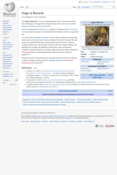
Back চেমাও গুজব Bengali/Bangla Fiktivní články od Zhemao Czech Canulars de Zhemao French झेमाओ धोखे Hindi Կեղծիքներ ռուսական պատմության մասին Վիքիպեդիայում (2022) Armenian Kebohongan Zhemao ID Zhemao-hoax Dutch Mistyfikacje Zhemao Polish Farsa de Zhemao Portuguese Мистификации о российской истории в Википедии (2022) Russian
The Zhemao hoaxes were a series of over 200 interconnected Wikipedia articles about falsified aspects of medieval Russian history written from 2012 to 2022 by an editor of the Chinese Wikipedia. Combining research and fantasy, the articles were fictive embellishments on real entities, as Zhemao used machine translation to understand Russian-language sources and invented elaborate detail to fill gaps in the translation. It has been described as one of Wikipedia's largest hoaxes.
She started this practice as early as 2010 on Chinese history topics, but turned to Russian history in 2012, and the political interactions of medieval Slavic states in particular. Many of her hoax articles were created to fill detail in her initial fabrications. Zhemao eluded detection for over a decade by obtaining the community's trust: faking a persona as a Russian history scholar, using sockpuppet accounts to feign support, and exploiting the community's good faith that her obscure sources matched the article content.
A Chinese novelist unraveled the web of hoax articles in a June 2022 online post, having initially been intrigued by a narrative about a Kashin silver mine before finding its sources to not pass verification. Zhemao posted an apology the same month and revealed herself to have neither an advanced degree nor fluency in English or Russian. She attributed her use of sockpuppet accounts to her loneliness and absence of other social relationships. Volunteer editors blocked her accounts and quickly deleted her hoax articles, though cleanup continued a month later. The incident renewed doubt about Wikipedia's reputation for reliability.
© MMXXIII Rich X Search. We shall prevail. All rights reserved. Rich X Search

